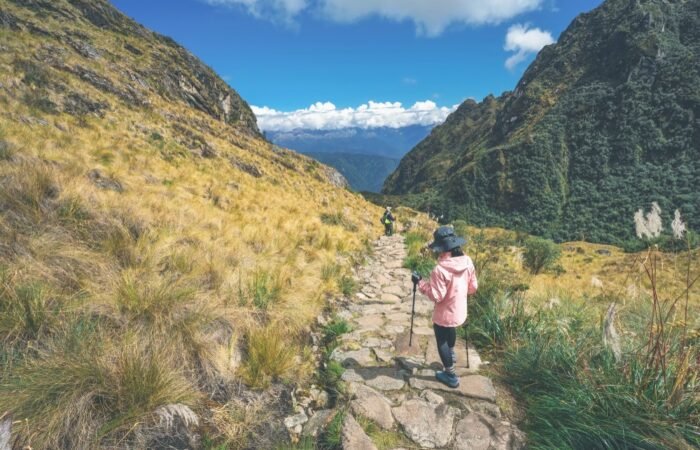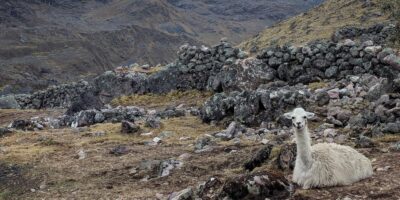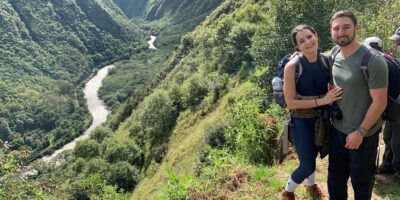

Reservations for the great year 2025 - 2026 have already started, more than 10,000 clients with reservations secured!
Are you thinking about taking a trip to Machu Picchu? What are you waiting for, make your reservation now and secure the best place to see Machu Picchu completely and live an unforgettable experience!.
We recommend booking it at least 2 months in advance as tickets are quite limited.
Very limited spaces See availabilityBook fast and easy on our website and keep track of your reservation with our most advanced booking system, be updated on our discounts every week.
















Lares trek 5 days is a beautiful hike in the Andes of the Sacred Valley of the Incas in the region of Cusco, the hike is really beautiful with incredible landscapes surrounded by Andean people who herd their alpacas and llamas, live a unique experience in this beautiful place and enjoy the hot springs, for sure it will be the best adventure of your life, and combines this beautiful hike with the original Inca Trail that will take you to Machu Picchu, an Inca city hidden in the mountains.
We’ll pick you up from your hotel at 5:00 AM. to start our fantastic adventure.
As we travel towards the Sacred Valley of the Incas, you’ll be able to witness so the city of Cusco waking from a night of heavy slumber.
After an hour of driving, we’ll stop in Calca to visit the local market. There, you’ll get a great experience of Andean culture and will be able to buy some last-minute things: snacks, fruit, water, etc. We’ll continue our journey for two more hours till we arrive at the Lares hot springs where we’ll be spoiled with an energizing breakfast in full view of the towering mountains.
After breakfast, we’ll take a dip in the warm waters of the hot springs. The recreational complex contains various pools of differing sizes and temperatures. The smallest is very hot. Be careful getting in! The local people say that these pools’ volcanic water hold medicinal value and helps in the treatment of bone and muscle illnesses.
It also is meant to help with stress and headaches. After spending a few minutes in the water, we’ll get back in the car to go to Punta Carretera (3,800 m / 12,467 ft).Here, we’ll have a meeting with our trekking team who will accompany us on the excursion. The porters will transport your luggage on horses and will wait for you at each campsite. The only thing you’ll need to worry about is enjoying the trek! The Lares trail won’t disappoint.
Soon, you’ll find yourself in front of the impressive Pacchayocc waterfall. It is the right gift of nature. From here, we’ll continue for about two more hours until we reach an area filled with lakes. There, we’ll enjoy a delicious lunch prepared by our chef.
After lunch, we’ll continue with our trek and arrive at the Willkikasa Pass, the highest point on the trail for the day, (4,400 m / 14,435 ft). Take it easy; altitude sickness is a serious thing! From here, it’ll be a quick hour and a half trek downhill to the campsite in Quiswarani.
In Quiswarani, you’ll have enough time to explore the town and visit some of the houses there. You’ll learn about the lifestyle and traditions of the people from this part of the world. We’ll also see the school where boys and girls speak Quechua, their mother tongue. You can bring toys, notebooks, or other school supplies to share with them if you’d like.
We’ll enjoy hot drinks while the sky darkens and the stars begin to appear. Finally, we’ll have dinner prepared in this same place. You’ll be able to stargaze and then take refuge in your tent to rest.
Today, we’ll wake up around 5:30 AM, being offered hot drinks. At this time, people from the town will already be taking their llamas and alpacas out to graze. Breakfast will be served as soon as we finish getting the luggage ready to go. We’ll fill our water bottles and receive snacks to start the day strengthened for the trail. There will be 3-4 hours of ascent toward the highest point of the entire trek: the Pachacútec Pass (4,700 m / 15,419 ft). We’ll hike upward in a zigzag to lessen the strain due to the altitude. The landscapes of this place are surprising.
You’ll see the beautiful lake of Palcoyo and the impressive Qanchispaccha waterfall. If you feel bad or too tired, don’t worry, we’ll always have an emergency horse available. We’ll find ourselves above the clouds once we get to the Pachacútec Pass. From there, the 360-degree view is truly astounding.
In front of you, you’ll see the majestic mountains of Pitusiray and Qolqe Cruz.Please take advantage of this point to take amazing photos because we’ll soon start going downhill! We’ll begin to a one-hour descent down the slope to a place where we’ll enjoy our lunch. Recuperate your energy, and you’ll still need to walk three more hours! Our campsite is found in the town of Cancha Cancha (3,950 m / 12,959 ft).
Here, 85% of the houses are made with traditional techniques and materials: stone walls and thatched roofs. Since our support team will be in charge of setting up the tents, you’ll have time to spend with the local people. After that, your guide will take you to one of the community houses to learn about their lifestyle. You’ll be able to see guinea pigs being raised and learn about traditional, hand-made textiles made of alpaca and llama wool. In the afternoon, you’ll enjoy hot drinks and dinner.
Just like every morning, our trekking team will wake you up with a hot drink to start the day in the best way. Once you re prepared, you’ll begin to the last leg of the trek. We’ll walk 4 hours downhill along a gorgeous path where you’ll see herds of llamas and alpacas again. We’ll pass fields of potatoes, fava beans, and other products.This is a fabulous opportunity to learn more about Andean agricultural techniques. We’ll start descending to a warmer area: the Sacred Valley. You’ll feel the changes between micro-climates and see different crops than you saw in the higher altitude areas. The Sacred Valley cultivates corn, quinoa, kiwi, peaches, avocados, and other fruits. Of course, this area is full of history and Inca culture. We’ll finish the tour in a small town called Huarán (2,920 m / 9,580 ft), where you’ll say goodbye to the trekking team and the horses. Here, you’ll enjoy a delicious, nutritional lunch.
In Huarán, transportation will be waiting for us to go through the Sacred Valley to the salt mines of Maras’s town. Here, at (3,000 m / 9,842 ft), a salty spring of water flows and spills out over the mountain’s slope. You’ll be able to see 3,000 small evaporation chambers that have been used since pre-Inca times. This salt has curative properties due to its minerals and which turn it a beautiful pink color. Local families possess every one of these chambers and support themselves by supplying salt to the towns in this zone. There’s a small shop where you can buy some of the pink salt if you’re interested.
After visiting the salt mines, the van will take us 45 minutes away to Ollantaytambo (2,792 m / 9,160 ft), a beautiful town located in the heart of the Andes. Here we’ll visit the Sun’s spectacular Temple, built with huge rocks, many of which were elegantly carved to create water fountains, stairs, and terraces.
You’ll spend the night in Ollantaytambo. Remember to go to bed early as our excursion will start very early in the morning.
After breakfast, we will go to the train station; you can make your last-minute purchases. When the Sun begins to shed its lights on the mountains, you’ll board the train that’ll take you – next to the sacred river of Urubamba – to the point known as Km 104 (2,100 m / 6,889 ft) where we begin the hike. There we’ll descend and cross a bridge to the Ministry of Culture of Peru’s control point. Don’t forget to bring your original passport; otherwise, you simply won’t be able to enter the Inca Trail. After walking 15 minutes, you’ll arrive at the archaeological centers of Chachabamba and Choquesuysuy. We’ll continue with an ascent over steps, and we’ll observe waterfalls and different types of orchids.
The walk will last for 4 hours until we reach Wiñaywayna (2,650 m / 8,694 ft). This sophisticated archaeological center shows not only the architectural mastery of the Incas but also their great agricultural capacity.
There the Incas were able to cultivate different products and, in turn, stabilize the hillside. The name Wiñay Wayna comes from a special type of orchid that grows abundantly in the area and whose translation into Spanish is “eternally young.” You’ll visit, on a 1-hour guided tour, more than 20 buildings in this place. Later, you’ll enjoy a delicious box lunch to recharge your batteries and continue with our walk. A 2-hour walk awaits us to the old official entrance of Machu Picchu: Inti Punku or Puerta del Sol (2,720 m / 8,923 ft). From there, you’ll see the citadel of Machu Picchu for the first time in a panoramic view. Let your heart feel the respect and powerful energy that ancient Peruvians felt when contemplating this sacred site.
We only have 30 minutes to descend to reach Machu Picchu (2,430 m / 7,972 ft) at sunset. At that time, the crowds of tourists have already left, and Machu Picchu, the mysterious golden reflection of the Tayta Inti or Padre Sol, is at peace again. However, we’ll tour the stone streets of Machu Picchu the next day, at sunrise.
We’ll board a bus that’ll take us 25 minutes to Aguas Calientes, a real miniature metropolis where you’ll find everything. You’ll spend the night there, in a comfortable hotel. After dinner, we recommend you rest early to make the most of the next day.
The most special day of all has arrived. In a few moments, you’ll be able to contemplate with your own eyes the fantastic archaeological site of Machu Picchu, one of the New 7 Wonders of the World. There’s nothing better than walking through Machu Picchu at dawn, almost in silence, when the soft yellow light covers everything from one side, and magical shadows are revealed.
Tourists will crowd this place in a few hours so enjoy the tranquility of these moments. We’ll visit the most important and significant sites of Machu Picchu on a 2-hour guided tour: temples, terraces, palaces, houses, the industrial sector, the fields of cultivation, the sacred rock of the Solar Clock or Intiwatana, among others.
After the guided tour, you’ll have free time to explore Machu Picchu at your leisure. If you managed to get the respective tickets, you could climb the mountains of Huayna Picchu or Machu Picchu Mountain. Remember that the ascent and descent time for both mountains is 3 hours. You can also walk to the Inca Bridge or simply tour this citadel guided by your intuition and the place’s energy.
Once you’ve finished your visit, we’ll return to Aguas Calientes on a bus and have lunch at one local restaurant (price not included). Later you’ll board the train that’ll take you to the Ollantaytambo station where our representative will be waiting for you. Then we’ll go to our private transport to the city of Cusco. We’ll drop you off at the door of your hotel at approximately 8:00 pm.
All information meetings are held in your hotel at 6:00 p.m., one night before the tour begins. If you cannot attend, you must coordinate another time at the Peru Hike offices. These meetings last approximately 30 to 45 minutes and there you will be given a small duffel bag, in which you’ll put all the belongings you intend to bring on the trek that won’t be in your day pack.
ou’ll receive a canvas case or duffel bag during your briefing. The porters will take them on the way and will deliver them to you when you get to each camp. They measure 66 cm / 2 ft. Long x 36 cm / 1 ft. Wide.
A maximum of 5 kg is allowed for each duffel bag that includes the weight of your sleeping bag, mat, clothes and other personal items.
The trek has to be paid for in full by at least 7.30 pm two days before departure. For example, if your tour departs on a Wednesday, then you must come to our office before 7.30 pm on Monday.
It would be much appreciated if you pay the trek balance in cash US dollars or local currency. You can withdraw some money from several ATMs along Avenida Sol (either in US dollars or local Peruvian Soles). You can pay by credit card or PAYPAL online, but you will have to pay an 6% service charge, charged by VISA and PAYPAL. We do not accept bank checks or payment of the balance by traveler’s checks.
Of course! During the travel, your main luggage can be stored at our office or at your hotel, both free of charge.
Any equipment that you are not going to need on the trek can be stored safely in your hotel. Nearly every hotel will provide this service. Don’t leave items of value with your bags, put them in the hotel safe and obtain an itemized receipt (In the unlikely case of theft many insurance companies require that you have a copy of the receipt itemizing all the items). Best put items such as credit cards inside a sealed, signed envelope for extra peace of mind.
Peru Hike can pick you up from your hotel, as long as it’s in the Historic Center of Cusco. The pickup time will be coordinated with your guide in the briefing. The pickup time may vary between 30 and 45 minutes due to traffic. Cusco is a very old city, therefore, it has many narrow cobbled streets. Some hotels and Airbnbs may be located on streets without access to cars or on long, steep slopes, making it difficult to transport luggage. We strongly recommend that you book accommodation with good access.
Returning from Machu Picchu requires quite a bit of logistics, but don’t worry. Everything is included in your tour!
Group tours are made up of different types of people. Physical conditions and ages can vary. By agreeing to be part of a group tour, you also accept that some people may be faster or slower than you. Therefore, each person can go at their own pace on the route. It may be the case that a group wishes to modify the tour; however, it will be the guide who decides, after consulting with all the participants, if said modifications can be made.
Strikes and demonstrations are usually frequent in Peru and this may interrupt some of our tours. Roads can be blocked and train tracks can be taken over. However, we will try to keep your excursion as planned, even if it means leaving the night before the scheduled date. Under these circumstances, tours may also be cancelled. In case of changes or cancellations, all situations will be coordinated with you by our operations department. Your safety is our highest priority and our decisions will be made to protect it.
You’re responsible for your objects during the tour. Please pay attention to where you leave your things and remember to take everything once you leave our trucks, tents, or restaurants.
Here are some other options that will suit your needs
The Lares Trek was an unforgettable experience. The landscape was diverse and stunning, and the people we met along the way were friendly and welcoming. The trek was challenging, but the sense of accomplishment we felt at the end was worth it. I would highly recommend this trek to anyone looking for an authentic and rewarding experience in Peru.
I did both the Lares Trek and the Inca Trail during my trip to Peru, and while they were both amazing experiences, the Inca Trail was definitely the highlight for me. The scenery was breathtaking, and the history and culture behind the trail made it even more special. The Lares Trek was also great, but it was less crowded and had a more rural feel to it.
The Lares Trek was tougher than I expected, but it was worth it for the stunning views and cultural experiences. The high altitude made it challenging, but our guide was very knowledgeable and helped us acclimate. The food was delicious, and the camping was comfortable. Overall, a great adventure!
I did the Inca Trail first and then the Lares Trek, and I have to say that both were amazing in their own way. The Inca Trail was more challenging and had more historical sites to see, but the Lares Trek offered a chance to see local communities and learn about their way of life. I would recommend doing both if you have the time and energy.
I loved the Lares Trek, but the Inca Trail was a once-in-a-lifetime experience. The Inca Trail was more challenging, but the views and history were unparalleled. The Lares Trek was great for its cultural experiences and hot springs, but it didn’t compare to the majesty of the Inca Trail.